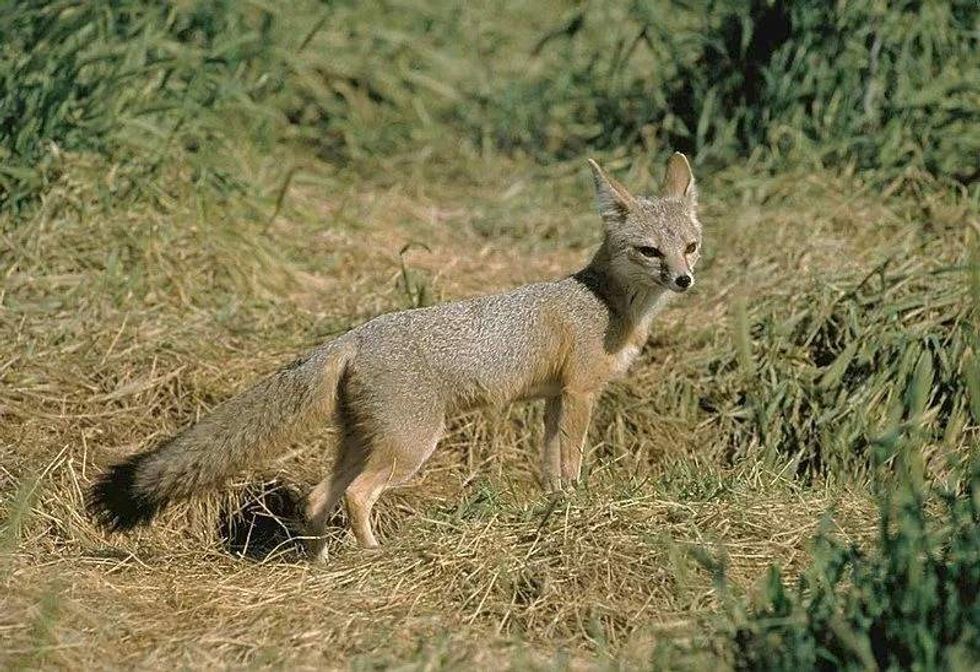The San Joaquin kit fox (Vulpes macrotis mutica) is a small subspecies of kit fox. They are considered to be the smallest member of the dog family in North America.
They were once a thriving species in the 1930s, with the California grasslands as their habitat.
In 1967 the government listed them as a rare species as they were threatened when often they lose the fear of people and expose themselves to danger from poison, sporting nets, and vehicles.
Thus the government made it unlawful for the public to handle or trap them as they are Endangered, and trapping them might injure or lead to their deaths.
For more relatable content, check out these river otter facts and European otter facts for kids.
San Joaquin Kit Fox Interesting Facts
What type of animal is a San Joaquin kit fox?
The San Joaquin kit fox (Vulpes macrotis mutica), or the San Joaquin fox, is an Endangered species of fox. They are generally hunters of insects, squirrels, rodents, rabbits, and the likes but will take advantage of whatever is available such as prairie dogs.
They mostly adapt to changes caused by urban development, but sometimes humans find themselves in conflict with this shy animal.
What class of animal does a San Joaquin kit fox belong to?
The San Joaquin kit foxes belong to the class Mammalia and are Endangered species of kit foxes. They have long, slim legs and slim bodies, with large ears that sit closely together and a slim and pointed nose. Their bushy tail is carried low and slightly narrowed towards its distinct black tip.
How many San Joaquin kit foxes are there in the world?
The Department of Fish and Wildlife, California, mentioned that the San Joaquin Foxes are rare and belong to the Endangered species. There have been observations of about 7000 numbers of Foxes left.
Where does a San Joaquin kit fox live?
The San Joaquin kit fox inhabits the grasslands and scrublands of the San Joaquin Valley in California, from southern Kern County north to eastern Contra Costa County and eastern Stanislaus county.
What is a San Joaquin kit fox's habitat?
The San Joaquin kit fox's habitat can be found in the grasslands of the San Joaquin Valley. Still, they sometimes modify their habitat, which includes irrigated pastures, orchards, vineyards, wind turbines, etc.
Their den is found rare in the areas with shallow soils because of proximity to bedrock, high water table, or impenetrable hardpan layers. The dens are used for protection and housing by the Joaquin kit foxes, and they may use several dens during the summer. The females may change the pupping den a few times over.
Who do San Joaquin kit foxes live with?
They are mostly found to live in pairs or in small groups though they den separately sometimes. Even during the mating season, the males and the females live together but have separate dens. The young foxes, once born, stay with the mother for four to five months and then scatter to live on their own.
How long does a San Joaquin kit fox live?
Normally, the kit foxes live up to seven years, but they can live as long as 10 years when they are kept in captivity.
How do they reproduce?
San Joaquin kit foxes can breed at one year of age. The adult pairs may stay together the full year but not have their den together.
The kit foxes change their dens often and the female focuses on preparing the dens for their pups through September and October. Mating may generally take place from December to March, and pups are born after around 48-52 days. The male fox provides the female with food while they are lactating.
The pups venture out of their dens only after a month. Reproductive success also depends on the availability of prey.
What is their conservation status?
San Joaquin foxes are Endangered species. Not many of these fox species remain because of habitat loss due to agriculture, industrial and urban developments. Since 1970, researchers have identified predation, shooting, poisoning, starvation, floods, droughts, and road kills as the main causes for the decline of their population.
San Joaquin Kit Fox Fun Facts
What do San Joaquin kit foxes look like?

They have large ears, slim bodies, long slender legs, and bushy tails. The tail is carried low and straight and slightly tapering towards the tip. They are brown or yellowish-grey in color. They have tan summer coats during summer and silver-gray coats in the winter. Their ears are dark on their inner sides, and their tail is black-tipped.
How cute are they?
The San Joaquin kit foxes are pretty cute as they are small, have large ears and tiny eyes that are very expressive.
How do they communicate?
Being a socially monogamous species, kit foxes are not exceptionally territorial and prefer to live in pairs or small groups. There have been observations of barking among the San Joaquin foxes. They are a series of short, discreet barking repeated in rapid sequences. The barking occurs mostly during the mating seasons.
How big is a San Joaquin kit fox?
The male San Joaquin kit foxes are 31.7 in (80.5 cm) in length, whereas the females are 30.3 in (76.9 cm). Females are often a little smaller than males. They are the smallest species of fox found in North America, but they are also the largest species of kit foxes. They have large ears and long legs.
How fast can a San Joaquin kit fox run?
They can run pretty fast as they are a species of fox. They also run fast to catch their prey like ground squirrels, kangaroo rats, birds, insects, considering their prey is pretty fast.
How much does a San Joaquin kit fox weigh?
The Joaquin kit foxes' weight range from 4-5 lb (2.1-2.3 kg), where the male weighs 5 lb (2.3 kg) and the female weighs 4.6 lb (2.1 kg).
What are the male and female names of the species?
The males are called dogs, reynards, or tods, and the females are called vixens.
What would you call a baby San Joaquin kit fox?
The babies of the kit foxes are called cubs or pups.
What do they eat?
The prey of the Joaquin kit fox, Vulpes macrotis mutica, varies between the north, central, and southern sections of the San Joaquin valley depending on the availability of food near or away from their habitat.
Animals like white-footed mice, pocket mice, California ground squirrels, kangaroo rats, black-tailed hares, and San Joaquin antelope squirrels are prey of the Joaquin kit foxes.
Are they dangerous?
The kit foxes are not dangerous, and they won't bite unless you tease them or pose a threat.
Would they make a good pet?
No, the kit foxes won't make a good pet even though sometimes they are bred in captivity. They are wild animals and are not easily domesticated.
Did you know...
San Joaquin foxes have also been termed an 'umbrella species,' which means the efforts to save this fox's habitat will also benefit native plants.
Why is the San Joaquin kit fox endangered?
Many factors have contributed to the decline of the San Joaquin kit foxes, but the reasons have varied over time.
By the 1950s, loss, degradation, and fragmentation of their habitat range became the chief factor that led to the decline of the San Joaquin Foxes.
The other factors include competition from the red fox and the extermination of the gray wolf from California has led the coyote to be the dominant predator in the forests and grasslands of California and thus disrupting the habitat of the San Joaquin kit foxes.
The San Joaquin kit fox recovery plan
The U.S Fish Wildlife Service developed a recovery plan for the San Joaquin kit foxes. The recovery plans include actions that FWS believes are required to recover and protect the particular species of kit fox.
In September 2007, 684 acres of Deadman Creek Conservation Bank were designated to protect the habitat of the endangered species of kit foxes by the Wildlands Inc.
Here at Kidadl, we have carefully created lots of interesting family-friendly animal facts for everyone to discover! Learn more about some other mammals from our Indian elephant facts and African bush elephant facts pages.
You can even occupy yourself at home by coloring in one of our free printable San joaquin kit fox coloring pages.









